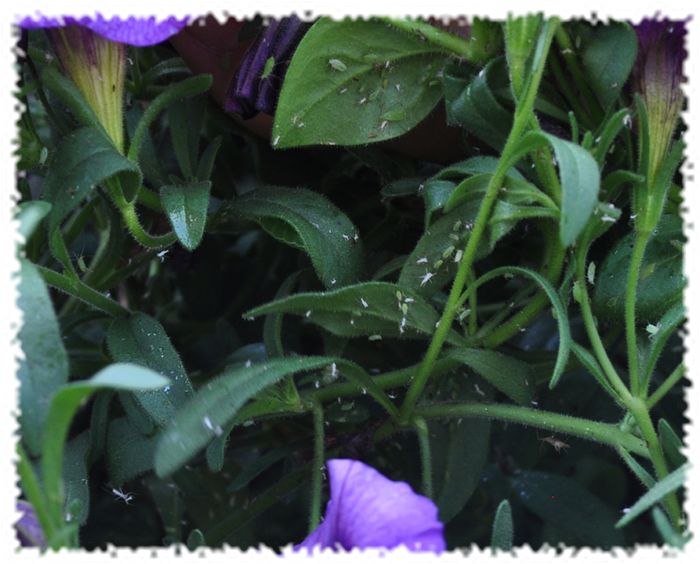Overview
Insects can pester any plant. The best way to help your plant resist them is to keep it healthy with adequate water, light, and fertilizer. However, even the healthiest of plants can become infested with insects or infected by disease. Checking your plants regularly, to insure you spot pests and diseases in the early stages, will help you treat the problem before it adversely affects the plant’s growth. The information below, while not comprehensive, provides illustrations and information on the most common pests/diseases and suggested treatments.
Checking for problems
Once a week, or so, lift up a section of the leaves/blooms to check the underside of the leaves (especially at the base). (Photo of healthy underside of plants) Insects often hatch in the cool, dark, protected underside of plants. By checking often you can spot and treat the problem before it stunts the plant’s growth. Also keep on eye on the top of the foliage to check for yellowing, browning, or other problems.
Symptoms
Insects can cause a variety of problems that may mimic the symptoms of improper water-fertilizer-light balance (see troubleshooting for more details on those symptoms). However, the presence of residues, webbing, eggs (or their castings) signal the presence of disease or infestation. It is worth repeating that regular checking is the key to identifying and treating problems before they severely damage or stunt the plant. If the problem you are encountering is not listed below, contact your local county extension agent for more information.
Common problems include:
Aphids
Aphids are small, green, plant-eating machines. They feed on the under-sides of leaves and can go unnoticed until plants are severely damaged. The average aphid size is about as big as a grain of white rice. A common sign of aphids is white, dandruff-like flakes. These are actually dead aphids.
Ladybugs are natural aphid predators. Unfortunately, they aren’t usually effective because they fly away after eating, leaving some aphids unscathed to reproduce quickly again. A more powerful solution is to use a chemical insecticide to kill all the aphids at once. Over the years, we have found the following products reliable for aphid control: Fertilome Systemic Drench For Trees and Shrubs, Orthene Turf, Tree, and Ornamental WSP, and Acephate 97UP. It is a good idea to switch products periodically to prevent insects from building up chemical immunity.
Spider Mites
(photo coming soon)
Thrip
(photo coming soon)
Budworm
Budworm (aka Tobacco Budworm) bore through flower buds, which then open with holes. If only a few blossoms have been affected, simply remove the damaged flowers. If the problems affect large areas of the plant, use a systemic insecticide to control the infestation. Remember to follow the manufacturer’s instructions carefully when using insecticides.
Leaf Miner
Leaf miner applies more to the symptom than to the cause. Several types of insect larvae and caterpillars can burrow between layers of leaf tissue, leaving behind the tell-tale marks on the leaves. The marks appear as white-gray or silver trails snaking across the leaves. Most of these larvae are host-specific, meaning that they only infest one type of plant. Therefore, it will be rare to get leaf miner on petunias and sweet potato vine.
Though it is possible to treat leaf miner with sprays, for most planters, physically removing infested leaves is adequate. Leaf miner does more damage to the aesthetic appeal of the plant than it does to the plant’s overall vigor. Removing infected leaves at the first sign of infection will greatly reduce the unslightliness of the leaf miner and will reduce its impact.
If leaf miner has been a consistent problem in your containers, consider replacing the soil with sterile soil and sterilize the container with a water-cholorine bleach solution (about one capful of bleach per gallon of water).

Better Quality ~
Less Maintenance